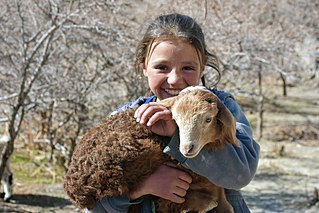
Tajikistan, officially the Republic of Tajikistan, is a landlocked country in Central Asia. Dushanbe is the capital and most populous city. Tajikistan is bordered by Afghanistan to the south, Uzbekistan to the west, Kyrgyzstan to the north, and China to the east. It is separated from Pakistan by Afghanistan's Wakhan Corridor.

The Demographics of Tajikistan is about the demography of the population of Tajikistan, including population growth, population density, ethnicity, education level, health, economic status, religious affiliations, and other aspects of the population.

Tajiks are a Persian-speaking Iranian ethnic group native to Central Asia, living primarily in Afghanistan, Tajikistan, and Uzbekistan. Tajiks are the largest ethnicity in Tajikistan, and the second-largest in Afghanistan and Uzbekistan. They speak varieties of Persian, a Western Iranian language. In Tajikistan, since the 1939 Soviet census, its small Pamiri and Yaghnobi ethnic groups are included as Tajiks. In China, the term is used to refer to its Pamiri ethnic groups, the Tajiks of Xinjiang, who speak the Eastern Iranian Pamiri languages. In Afghanistan, the Pamiris are counted as a separate ethnic group.

Dushanbe is the capital and largest city of Tajikistan. As of January 2022, Dushanbe had a population of 1,201,800 and that population was largely Tajik. Until 1929, the city was known in Russian as Dyushambe, and from 1929 to 1961 as Stalinabad, after Joseph Stalin. Dushanbe is located in the Gissar Valley, bounded by the Gissar Range in the north and east and the Babatag, Aktau, Rangontau and Karatau mountains in the south, and has an elevation of 750–930 m. The city is divided into four districts, all named after Persian historical figures: Ismail Samani, Avicenna, Ferdowsi, and Shah Mansur.

Tajik, also called Tajiki Persian or Tajiki, is the variety of Persian spoken in Tajikistan and Uzbekistan by Tajiks. It is closely related to neighbouring Dari of Afghanistan with which it forms a continuum of mutually intelligible varieties of the Persian language. Several scholars consider Tajik as a dialectal variety of Persian rather than a language on its own. The popularity of this conception of Tajik as a variety of Persian was such that, during the period in which Tajik intellectuals were trying to establish Tajik as a language separate from Persian, prominent intellectual Sadriddin Ayni counterargued that Tajik was not a "bastardised dialect" of Persian. The issue of whether Tajik and Persian are to be considered two dialects of a single language or two discrete languages has political sides to it.

The Tajik Soviet Socialist Republic, also commonly known as Soviet Tajikistan, the Tajik SSR, or simply Tajikistan, was one of the constituent republics of the Soviet Union which existed from 1929 to 1991 located in Central Asia.

Bokhtar, previously known as Qurghonteppa, Kurganteppa and Kurgan-Tyube, is a city in southwestern Tajikistan, which serves as the capital of the Khatlon region. Bokhtar is the largest city in southern Tajikistan, and is located 100 kilometres (62 mi) south of Dushanbe and 150 kilometres (93 mi) north of Kunduz, Afghanistan.

Khujand, sometimes spelled Khodjent and known as Leninabad from 1936 to 1991, is the second-largest city of Tajikistan and the capital of Tajikistan's northernmost Sughd province.

Gorno-Badakhshan, officially the Badakhshan Mountainous Autonomous Region, is an autonomous region in eastern Tajikistan, in the Pamir Mountains. It makes up nearly forty-five percent of the country's land area but only two percent of its population.
Jews and Judaism in Tajikistan have a long and varied history. Many of the Tajik Jews were originally Bukharan Jews.

The Tajikistani Civil War, also known as the Tajik Civil War, began in May 1992 and ended in June 1997. Regional groups from the Garm and Gorno-Badakhshan regions of Tajikistan rose up against the newly-formed government of President Rahmon Nabiyev, which was dominated by people from the Khujand and Kulob regions. The rebel groups were led by a combination of liberal democratic reformers and Islamists, who would later organize under the banner of the United Tajik Opposition. The government was supported by Russian military and border guards.

National delimitation in the Union of Soviet Socialist Republics was the process of specifying well-defined national territorial units from the ethnic diversity of the Union of Soviet Socialist Republics (USSR) and its subregions.

Soviet Central Asia was the part of Central Asia administered by the Soviet Union between 1918 and 1991, when the Central Asian republics declared independence. It is nearly synonymous with Russian Turkestan in the Russian Empire. Soviet Central Asia went through many territorial divisions before the current borders were created in the 1920s and 1930s.
The Yaghnobi people are an East Iranian ethnic minority in Tajikistan. They inhabit Tajikistan's Sughd province in the valleys of the Yaghnob, Qul and Varzob rivers. The Yaghnobis are considered to be descendants of the Sogdian-speaking peoples who once inhabited most of Central Asia beyond the Amu Darya River in what was ancient Sogdia.

Qahhor Mahkamov was a Tajik politician who served as First Secretary of the Communist Party of Tajikistan from 1985 to 1991 and was the first President of Tajikistan from November 1990 until his fall in the August 1991 coup.
CSKA Pamir Dushanbe is a professional football club based in Dushanbe, Tajikistan that currently plays in the Tajikistan Higher League, the country's top division. Since 1997, the club has been under the patronage of the Tajik Army, like its former rivals CSKA Dushanbe.

The Pamiris are an Eastern Iranian ethnic group, native to Central Asia, living primarily in Tajikistan (Gorno-Badakhshan), Afghanistan (Badakhshan), Pakistan (Gilgit-Baltistan) and China. They speak a variety of different languages, amongst which languages of the Eastern Iranian Pamir language group stand out. The languages of the Shughni-Rushani group, alongside Wakhi, are the most widely spoken Pamir languages of this area.

Islam is the predominant religion in Tajikistan.

The following outline is provided as an overview of and topical guide to Tajikistan:

The 1990 Dushanbe riots marked a period of heightened civil disobedience and inter-ethnic violence in the capital city of the Tajik SSR of the Soviet Union. Existing tensions over lacking economic and political reforms were exacerbated by the arrival of Armenian refugees from the Azerbaijan SSR due to the Nagorno-Karabakh conflict. The mass movement of Tajik nationalists, anti-communists, and Islamists targeted ethnic minorities, such as Armenians and Russians, as well as unaffiliated Tajiks—namely women who did not conform to Islamic clothing standards. By late 1991, the dissolution of the Soviet Union gave way to the Republic of Tajikistan declaring independence, though this was followed by the Tajikistani Civil War less than a year later.

















